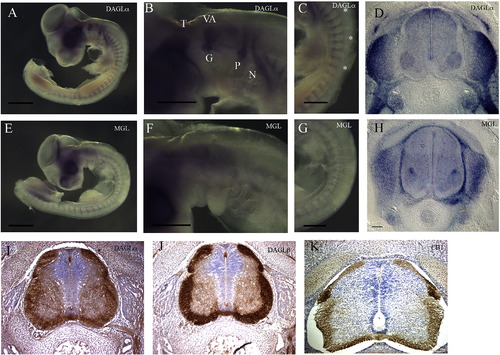Fig. 3
- ID
- ZDB-FIG-080507-13
- Publication
- Watson et al., 2008 - The endocannabinoid receptor, CB1, is required for normal axonal growth and fasciculation
- Other Figures
- All Figure Page
- Back to All Figure Page
|
Analysis of the expression of the enzymes involved in the synthesis and catabolism of 2-AG. (A–D) Expression of DAGLα. (A) Side view of a stage 20 whole embryos showing expression of DAGLα in the cranial ganglia and spinal nerves. (B) Higher power view of the head showing expression in the developing cranial ganglia. (C) Higher power view of the trunk showing expression in the spinal nerves. (D) Section through the spinal cord at the forelimb level at stage 29, showing broad expression in the nerve cord, and expression in the DRGs and sympathetic ganglia. (E–H) Expression of MGL. (E) Side view of a stage 20 whole embryo hybridised for MGL. (F) Higher power view of the head. (G) Higher power view of the trunk. (H) Section through the spinal cord at the forelimb level at stage 29, showing broad expression in the nerve cord, at high levels in one group of interneurons, expression in the surrounding vasculature, and in the DRGs and sympathetic ganglia. (I–K) Sections through the spinal cord on an E6 chick stained with anti-DAGLα (I), anti-DAGLβ (J) and CB1 (K) antisera. |
Reprinted from Molecular and cellular neurosciences, 38(1), Watson, S., Chambers, D., Hobbs, C., Doherty, P., and Graham, A., The endocannabinoid receptor, CB1, is required for normal axonal growth and fasciculation, 89-97, Copyright (2008) with permission from Elsevier. Full text @ Mol. Cell Neurosci.

